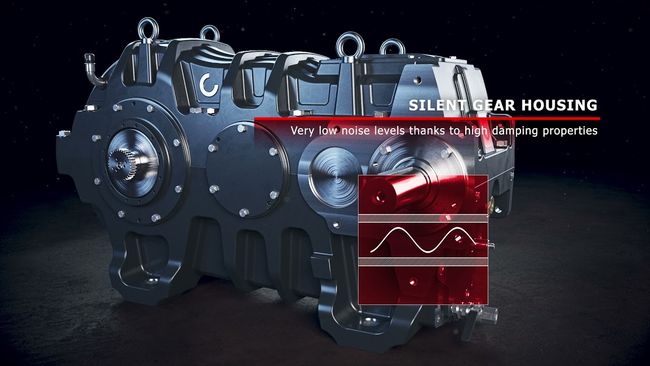As global trade expands, some container terminals have been moving closer to urban centers for easier intermodal logistics. Their 24/7 operations are full of industrial equipment making noise that affects nearby residents. Although crane operators can be protected from it inside insulated cabins, other on-site personnel can be exposed to loud noise up close for hours every working day.
A silent crane could be part of the solution for both logistics workers and the public.
Can’t hear yourself think
At logistics hubs, container terminals can be particularly loud due to an almost continuous flow of traffic arriving and leaving, ships docking, port machinery, warning signals and alarms. Depending on the amount of activity, the overall level can vary quite a lot, but the fact remains that all operating terminals emit noise.
Included in this cacophony are the Rubber-Tired Gantry cranes (RTGs) and Rail-Mounted Gantry cranes (RMGs) that shift containers around the container yard. A spreader makes contact with a container, and the motor of the crane runs the gears that channel the ropes across pulleys and the container is hoisted up. The trolley moves or the crane drives to a new location or both, and it lowers the container to the top of a stack of containers or the back of a vehicle. It’s all made of metal, and when metal touches metal, it creates audible impulses – in other words, noise.
Imagine a fleet of 10 RTGs all making 25 movements per hour. That’s 250 movements multiplied by 24 hours, which comes to 6,000 movements at irregular intervals every day. And the cranes don’t switch off in between movements - there is a continuous engine hum in the background.
movements multiplied by 24 hours, which comes to 6,000 movements at irregular intervals every day. And the cranes don’t switch off in between movements - there is a continuous engine hum in the background.
Wherever possible, container yards are located in industrial areas that are far away from where people live. But in today’s modern cities, everything is closer, as the demand for seafront property has risen. Then there are inland, intermodal yards that have been built well after original city plans were drawn up. International trade has expanded, and container terminals need to run around the clock.
Whether the people exposed to noise are residents or workers, the World Health Organization (WHO) notes that excessive noise can seriously harm human health, including disturbed sleep, heart problems and elevated stress.
Earplugs and other hearing protection devices are not enough. Something needs to be done to avoid affecting the long-term health of those nearby.
Breaking the sound barrier
Konecranes put an R&D team to work exploring the science of vibration and related noise in RMGs and RTGs. Common in container yards, these machines seemed like a good place to begin. Taking a holistic approach, they started with a static expert analysis, which provided baseline measurements. They then moved on to simulations.
During operation, sound is always present around a crane, but noise levels are never constant, so simulations allow researchers to safely manipulate capacity, hoisting and traveling motions, performance and other important factors that affect the measurable sound surrounding the crane and thereby gather clues on how to reduce noise. A simulation also gives the opportunity to compare possible solutions and choose the best option before physical testing with real Konecranes products.
 Konecranes build their products around an integrated package of key components – gears, motors and controls – that they have designed and manufactured themselves. Intended only for use in cranes, these components are made to work together seamlessly as the Core of Lifting.
Konecranes build their products around an integrated package of key components – gears, motors and controls – that they have designed and manufactured themselves. Intended only for use in cranes, these components are made to work together seamlessly as the Core of Lifting.
The research team has extended the Konecranes Core of Lifting and developed silent components. Konecranes now offers a silent gear reducer and a silent motor in RTG and RMG hoisting systems that deliver much more silent lifting. These components operate smoothly and minimize other vibrations during high-speed operations such as lifting, when the loudest sounds usually occur. The hoist is only one noise source in a big container terminal, but tests show that a hoist with these components can lower crane noise by 6-10 dB. That doesn’t sound like much, but it adds up quickly over several machines.
The level of sound produced by operating a crane also drops when crane movements are accurate, so semi-automation using Smart Features to assist crane operators can be another way to reduce noise. Remote operation, from a control room at another location, can remove crane operators from the immediate environment of constant noise exposure.
Research has demonstrated that the best way to minimize sound emissions is from the very start of crane design. Silent components do it well.
The sound of silence
As people have become more aware and active in their daily health management, the noise in living and working environments has become an important social issue. Although the WHO publishes its own general guidelines, these are not legally binding. Many local authorities around the world, particularly in continental Europe, have very strict regulations on the management of noise that affects residential areas and employees working in noisy areas. Konecranes ensures that terminal operators have low-noise cranes that comply with these laws.
Yet silent components go one better: rather than just following rules, they make reducing sound a top priority. Although only silent hoists for RTGs and RMGs are currently available, Konecranes has a pipeline of other silent component packages in development. Konecranes has also delivered special Ship-to-Shore (STS) cranes to customers needing extra silent quayside container handling. These cranes contain many special sound damping properties.
The ultimate goal is a fully silent crane. Imagine a whole fleet of these big, quiet machines.
As electrification becomes more widespread, it’s good to understand that this also reduces noise, eliminating the constant rumble of a diesel engine in the background during operation.
But because every container terminal is different, silent cranes might not be enough. With their industry-leading expertise in noise simulation and control, Konecranes can design an entire container terminal from the beginning, or provide the expertise needed to upgrade an existing terminal with better sound dynamics for its employees and nearby residents. This is exactly what modern logistics hubs need as international trade grows, urban areas expand, and noise legislation becomes stricter.
Already today, Konecranes can supply the silent core components, designed in-house specifically for cranes, that make crane hoisting quieter. In the foreseeable future, they will be able to offer entirely silent cranes. Eventually, maybe the whole terminal will operate at a whisper.
It all starts with the silent components from Konecranes.

 movements multiplied by 24 hours, which comes to 6,000 movements at irregular intervals every day. And the cranes don’t switch off in between movements - there is a continuous engine hum in the background.
movements multiplied by 24 hours, which comes to 6,000 movements at irregular intervals every day. And the cranes don’t switch off in between movements - there is a continuous engine hum in the background.  Konecranes build their products around an integrated package of key components – gears, motors and controls – that they have designed and manufactured themselves. Intended only for use in cranes, these components are made to work together seamlessly as the Core of Lifting.
Konecranes build their products around an integrated package of key components – gears, motors and controls – that they have designed and manufactured themselves. Intended only for use in cranes, these components are made to work together seamlessly as the Core of Lifting. 
